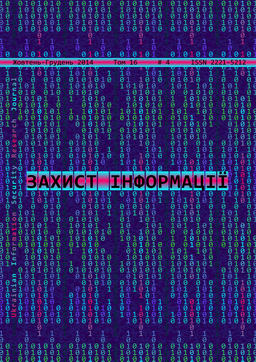Inequality of computational effort of Pollard p-method according to dispaly selection and initial estimate for small-scale factorizable amounts
DOI:
https://doi.org/10.18372/2410-7840.16.7609Keywords:
factorizatio, Pollard p factorization method, initial estimate, presentation in the residue ring, computational complexityAbstract
For a range of information security tasks the cryptostrengthof algorithms applied is linked to solving acomputational problem of multi-digit numbers factorization.Algorithms of modern factorization methods canuse existing algorithms as integral part. That is why aresearch of existing methods and development of the wayto accelerate their work is considered to be a highly topicalproblem. For Pollard p factorization method generalevaluation of iterations number is known, but the resultsof initial approximation influence study have not beenpresented. To evaluate such influence it is suggested todefine the average number of iterations for Pollard factorization method in the context of numbersoptions of 2*107 not exceeding 231, of the N=p*q type,where p and q are prime factors. While defining the averageiterations number the total iterations count for alloptions of N under study was calculated and divided bythe number of these options. To provide factoring constantc in the polynomial was increased by one wheneveriteration process ran into a cyclic path. Studies are conductedto evaluate the average iterations number dependingon the choice of constant c in the polynomial, representingiteration process 21 ( )mod k k x x c N , as well ason initial estimate. It has been defined that for the numberoptions under study the average iterations number islower than existing evaluations, and it can be decreased byone third, due to the initial estimate.References
. Саломаа А. Криптография с открытым ключом: пер. с англ. / А. Саломаа. – М.: Мир, 1996. – 318 с.
. Song Y. Yan. Cryptanalytic attacks on RSA / Song Y. Yan. – Springer Science and Business Media, Inc. 2008. – Р. 255.
. Ростовцев А.Г. Теоретическая криптографія / А.Г. Ростовцев, Е.Б. Маховенко. – СПб: АНО НПО «Профессионал», 2004. – 480 с.
. Горбенко И.Д. Анализ каналов уязвимости системы RSA / И.Д. Горбенко, В.И. Долгов, А.В. Потий, В.Н. Федорченко // Безопасность информации. – 1995. – № 2. – С.22 – 26.
. Daniel R.L. Brown. Breaking RSA May Be As Difficult As Factoring [Электронный ресурс]. – Режим доступа: http://www.pgpru.com/novosti/2005/1026vzlomrsabezfaktorizaciirealenoneeffektiven. – Название с экрана.
. Василенко О.Н. Теоретико–числовые алгоритмы в криптографии / О.Н. Василенко. – М.:МЦНМО, 2003. – 328 с.
. Кормен Т. Алгоритмы: построение и анализ / [Кормен Т., Лейзерсон Ч., Риверст Р., Штайн К.]. – [2-е изд.]. – М.: Вильямс, 2011. – 1296 с.
. Brent R.P. An improved Monte Carlo factorization algorithm / R.P.Brent // BIT. – 1980. – V. 20. – Pp. 176-184.
. Pollard J.M. A Monte Carlo method for factorization / J.M. Pollard // BIT. – 1975. – V. 15. – Pp. 331 – 334.
. Кнут Д. Искусство программирования. Т. 2. Получисленные алгоритмы / Д. Кнут. – М.: Вильямс, 2000. – 788 с.
. Винничук С.Д. Алгоритм Ферма факторизации чисел вида N=pq методом прореживания / С.Д. Винничук, А.В. Жилин, В.Н. Мисько
// Электронное моделирование, 2014. – Т. 36, № 2. – С. 3-14.
Downloads
Published
Issue
Section
License
Authors who publish with this journal agree to the following terms:- Authors retain copyright and grant the journal right of first publication with the work simultaneously licensed under a Creative Commons Attribution License that allows others to share the work with an acknowledgement of the work's authorship and initial publication in this journal.
- Authors are able to enter into separate, additional contractual arrangements for the non-exclusive distribution of the journal's published version of the work (e.g., post it to an institutional repository or publish it in a book), with an acknowledgement of its initial publication in this journal.
- Authors are permitted and encouraged to post their work online (e.g., in institutional repositories or on their website) prior to and during the submission process, as it can lead to productive exchanges, as well as earlier and greater citation of published work (See The Effect of Open Access).

